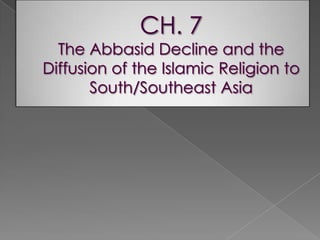
Ch.7
- 1. CH. 7 The Abbasid Decline and the Diffusion of the Islamic Religion to South/Southeast Asia
- 2. The Downfall of the Abbasid The Major Reasons of Decline Peasant Revolts due to high taxes Al-Mahdi and successors civil wars -succession ( al-Amin vs. al- Ma'mun) Turkish slaves as army imperial treasury running out of funds Invasion of the Buyids fallowed by Seljuk Turks and then finally Mongols. Tension between Shiite and Sunni
- 3. Causes of Decline connected...
- 4. The First Islamic invasion and the Second Islamic Invasion The Second Islamic Invasion The First Islamic Invasion Most Indians stayed Hindu/Buddhist Religious tolerance with lower taxes than the Hindu Indians had a great influence with dress and building structure Mathematical, scientifical, and medical advance brought to the Muslim region Mahmud of Ghazni started a series of violent conquest Sultans of Delhi ruled for 300 years with the assistance of the Hindu people Converts to Islam were not won over by force but by trade and the Sufi mystics. The Hindus saw the Muslims as a threat ( cults) Effaces on the superiority of Hinduism over Islam.
- 8. Vocabulary Al-Mahdi – Third of Abbasid caliphs. Harun al-Rashid – Most famous Abbasid caliphs; his death started a civil war over succession. Buyids – Regional splinter dynasty of the mid- 10th century; invaded and captured Baghdad. Seljuk Turks – Nomadic invaders from central Asia via Persian. Crusades – Military adventures that were launched by western Christians to free the Holy Land the Muslims. Saladin – Muslim leader in the last decades of the 12th century; reconquered most of the crusader outposts for Islam. Shah-Nama – Written by Firdawsi in late 10th and early 11th centuries. Ulama –Orthodox religious scholars within Islam. Al- Ghazali – A talented Islamic theologian; attempted to combine Greek and Qur’anic traditions. Sufis – Mystics within Islam; responsible for expansion of Islam to southeast Asia and other regions. Mongols – Central Asian nomadic peoples. Chinggis Khan – Was born in the 1170s in decades after the death of Kabul Khan; elected khagan of all Mongol tribes in 1206; conquered northern kingdoms of China, and as far as the Abbasid regions.
- 9. Vocabulary (con…) Hulegu – Ruler of the Ilkhan khanate; grandson of Chinggis Khan. Mamluks – Muslim slave warriors; defeated the Mongols at AinJalut in 1260 and stopped Mongol advance. Muhammad ibnQasim – was an Arab general; conquered Sind in India; declared the region an the Indus valley to be part of Umayyad Empire. Mahmud of Ghazni – led a series of expeditions that began nearly two centuries of Muslim raiding and conquest in northern India. Muhammad of Ghur – Military commander of Persian extraction who ruled a small mountain kingdom in Afghanistan. Qutb-ud-din Aibak – Lieutenant of Muhammad of Ghur; established kingdom in India with capital at Delphi. Bhaktic cults – Hindu groups that were dedicated to gods and goddesses; they also stressed the importance of strong emotional bonds between devotees and the god or goddess who was the object of their veneration. Mira Bai – Famous Hindu writer religious poetry. Kabir – Mslim mystic; played down the importance of ritual differences between Hinduism and Islam. Shrivijaya – Trading empire centered on Malacca Straits between Malaya and Sumatra. Malacca – Was a Portuguese factory or fortified trade town located on the tip of the Malayan peninsula. Demak – Most powerful of the trading states on north coast of Java, and was converted to Islam.
- 12. 750 C.E. – Establishment of the Abbasid caliphate (Baghdad)
- 14. 777 C.E. – Independent dynasty formed in Algeria
- 16. 788 C.E. – Independent dynasty formed in Morocco
- 18. 809 C.E. – First war of succession between Abbasid princes
- 20. 945 C.E. – Persian Buyids capture Baghdad; the caliphs become puppet rulers
- 22. 998 C.E. – Beginning of Ghanzi raids into western India
- 24. 1055 C.E. – Seljuk Turks overthrow Buyids, control caliphate
- 26. 1096 C.E.- 1099 – First Christian Crusade in Palestine
- 28. 1290s C.E. – Beginning of the spread of Islam in southeast Asia
- 31. Pictures and Maps The coperacen between the expantion and spread of Islam from 661 c.e. up to the last days of the Ottoman Empire.
- 32. Pictures and Maps (cont…) The Abbasid Caliphate was at its hight under Harun al- Rashid’s reign. His administration had reached all the way to north Africa and south Asia.
- 33. Trade Routes between India/arabia /southeast asia The trade routes helped move the Islamic religion